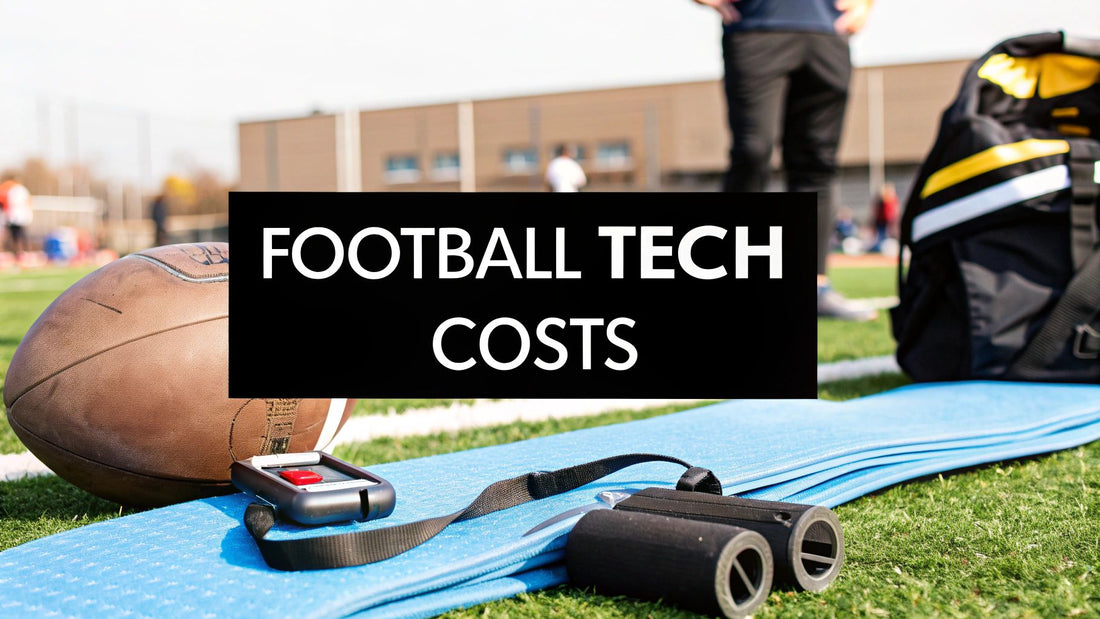So, you’re wondering what all this football tech is going to set you back? The short answer is: it varies. A lot. You could be looking at anything from under £50 for a simple training app to well over £500 for the kind of GPS system you see the pros using.
This guide will break down the numbers, helping you figure out where to invest your money for the biggest impact on your child's game.
Decoding the Investment in Youth Football Tech
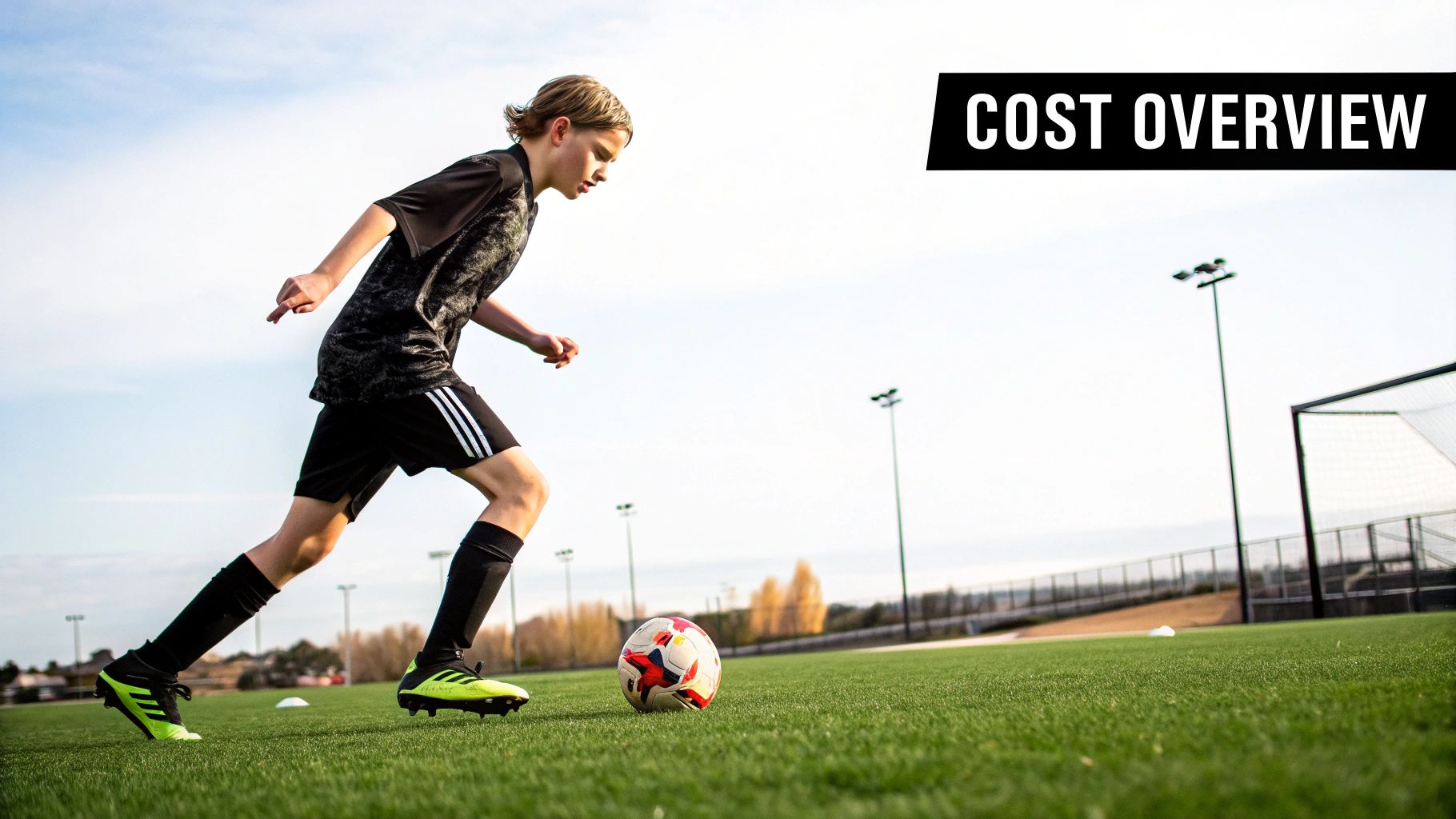
Dipping a toe into the world of football technology can feel a bit daunting, especially when you see the huge range of prices. It’s not just about buying another gadget; it's about understanding what you’re getting for your money and whether it genuinely matches your young player's needs and passion for the game.
Our goal is to give you a clear financial picture from the start. Think of it like buying their first proper pair of football boots. You wouldn’t start with the pro-level £250 pair, would you? You start with something affordable and functional, and as their skills and commitment grow, you can upgrade. The same logic applies here.
To help you get a handle on things, let's break down the typical costs into three main tiers. This should give you a good idea of what to expect at different price points.
Three Common Investment Tiers
- Budget-Friendly Starters (£30 - £100): This is your entry point. Think smartphone apps, basic smart footballs, and simple rebounders. This gear is perfect for introducing tech-driven training without a big financial commitment.
- Mid-Range Performers (£100 - £250): In this bracket, you'll find more advanced smart balls, entry-level GPS trackers, and interactive training mats. This equipment offers more detailed feedback and is ideal for players who are starting to take their development seriously.
- Premium and Academy-Level Kits (£250+): This is the top end. We’re talking high-end GPS systems (often with subscriptions), sophisticated analysis software, and advanced rebounders. This level is typically for dedicated young athletes already in, or aiming for, an academy environment.
To make it even clearer, here’s a quick summary of what you might expect to pay for some of the most popular items.
Estimated Costs for Popular Kids' Football Tech
This table gives you a rough idea of the price ranges for different types of football tech here in the UK.
| Technology Type | Budget Range (£) | Mid-Range (£) | Premium Range (£) |
|---|---|---|---|
| GPS Trackers | £80 - £120 | £120 - £200 | £200 - £350+ |
| Smart Footballs | £30 - £60 | £60 - £100 | £100 - £150+ |
| Rebounders | £50 - £100 | £100 - £250 | £250 - £500+ |
| Training Mats | £40 - £70 | £70 - £120 | £120 - £200+ |
Keep in mind these are just estimates. Prices can shift based on brand, features, and whether there's a subscription involved, but it’s a solid starting point for your budget.
This guide breaks down typical investment levels, from budget-friendly starter gear to the advanced kits used by top academies. We'll explore what drives these costs and how to make the smartest choice for your child's journey in the beautiful game.
Understanding the Different Types of Football Tech
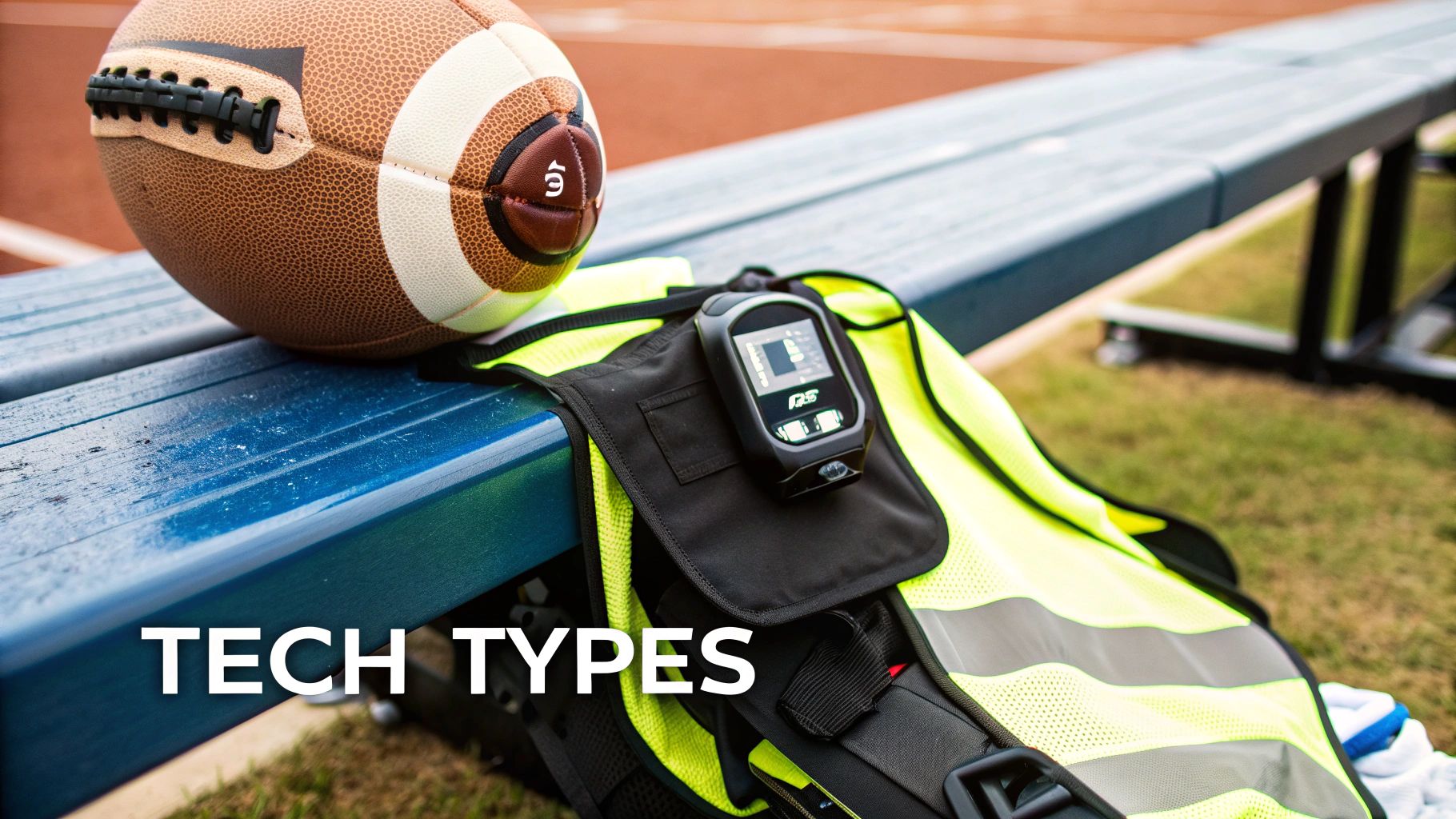
Before you can think about a budget, it helps to know what’s actually out there. The world of football tech can feel a bit overwhelming at first, but it really boils down to a few key categories, each one designed to improve a different part of your child's game.
Figuring out the cost of football tech for kids becomes much easier once you understand what these tools do. Some are all about physical performance and safety, while others help sharpen the finer points of technique. Let's break down the main types of gear you’ll come across.
Wearable GPS Vests
Think of a GPS tracker as a personal performance map for your child. Tucked into a lightweight vest, these small devices monitor every sprint, turn, and jog they make on the pitch. They track key stats like total distance covered, top speed, and the number of high-intensity sprints.
But this isn't just about chasing impressive numbers. It’s a crucial tool for managing workload. By seeing their physical output, you and their coach can spot if they're being pushed too hard, which is a massive help in preventing burnout and reducing the risk of injury. Popular brands like STATSports and Catapult lead the way here.
Smart Footballs
A smart football is like having a digital coach built right into the ball, giving instant feedback on every strike. Packed with sensors, these balls connect to an app on your phone to measure things like shot power, spin rate, and strike point accuracy.
Suddenly, solo practice becomes far more engaging and effective. Instead of just booting a ball against a wall, your child gets real-time data that helps them understand why a shot went wide or how to get more curl on the ball. It turns repetitive drills into a bit of a video game. The Adidas miCoach and Wilson X Connected are popular examples.
"Tech should complement, not replace, traditional coaching. The best gadgets are those that make a young player more mindful of their own technique and effort, turning practice into a more purposeful activity."
Digital Rebounders and Training Mats
Let’s be honest, keeping solo practice interesting is a constant battle. This is where digital rebounders and interactive training mats come in, designed specifically to add a layer of fun and competition to individual drills.
- Smart Rebounders: These are much more than just a bouncy net. They often come with light-up targets and app connectivity, creating drills that seriously test a player's first touch, reaction speed, and passing accuracy. A good example is the SKLZ Quickster.
- Interactive Mats: Brilliant for indoor practice on rainy days, these mats guide players through tricky footwork drills. They often use lights and sounds to make coordination and ball control exercises feel more dynamic. You can find some great options for home training in the SoccerWares collection.
Performance Analysis Apps
Finally, you have the brains of the operation: performance analysis apps. These apps take all the raw data gathered from GPS vests, smart balls, or even just video clips from your phone, and translate it into simple, understandable advice for young players.
They use clear charts and graphics to show strengths and pinpoint areas for improvement. Some even let you track performance over time, giving you clear proof that all that hard work is paying off. It's all about turning complex data into simple, actionable insights that a child can actually use to get better.
The Real Price of Performance GPS Trackers
GPS trackers are one of the biggest investments you can make in a young player's football journey, but what are you actually paying for? These little pods offer an incredible window into performance, helping you manage workload, spot injury risks, and see a player's real physical strengths on the pitch.
But the cost of football tech for kids, especially these trackers, isn’t as simple as the price on the box. Before you jump in, it’s crucial to understand the full financial picture.
The Two Core Costs of GPS Tracking
When you buy a GPS system, you're almost always paying for two different things. Think of it like a new mobile phone: you pay for the handset itself, and then you pay for the monthly plan that lets you use it.
First up is the initial hardware purchase. This is your one-off payment for the physical GPS pod and the specialised vest that holds it snugly in place during a match or training.
The second part, which often catches people by surprise, is the ongoing subscription fee. Most brands require a monthly or annual subscription to unlock the app where all the data is collected, analysed, and turned into something you can understand. This fee is what powers the software that makes sense of all the raw numbers.
Comparing Entry-Level and Academy-Grade Systems
The price of a GPS tracker can swing wildly, and it really comes down to who it’s built for. For an individual player who’s just getting serious, an entry-level model like the STATSports Apex Athlete Series is usually more than enough. These trackers are brilliant for personal use and focus on the core metrics that matter.
At the grassroots level, the cost of football technology for kids in the UK has seen a significant rise. Many youth academies have incorporated wearable GPS trackers. For instance, devices like the Catapult GPS vests can cost between £400 and £1,000 each, with clubs needing multiple units. Additionally, software licences for detailed analysis programs can range from £1,000 to £5,000 per year. Discover more insights into grassroots football spending on teamgrassroots.co.uk.
On the other end of the scale, you have high-end systems used by professional academies. These offer a much deeper level of analysis and are designed for monitoring an entire team. They let coaches compare player stats, manage squad-wide fitness, and pull detailed reports. It’s these advanced, multi-user features that push the price up.
If you want a full breakdown of what these devices can do, have a look at our complete guide on soccer GPS tracking systems.
You can explore a selection of GPS trackers suitable for various levels and budgets on soccerwares.com, ensuring you find the right fit for your young athlete’s development journey.
Investing in Smart Balls and Training Aids
Beyond tracking stamina on the pitch, modern tech offers fantastic tools for sharpening specific skills. Smart footballs and digital training aids are designed to make solo practice more engaging and productive, giving young players the instant feedback they need to nail their technique.
These gadgets essentially turn repetitive drills into fun, interactive challenges. Take a smart ball, for instance. It's packed with sensors that measure key parts of a kick. The second the ball is struck, it sends data on spin, power, and strike accuracy straight to a smartphone app. This gives a player immediate, useful insights they can use to adjust their very next shot.
This shifts the focus from pure physical effort to technical precision. So, when we talk about the cost of football tech for kids in this area, we're looking at tools that build fundamental skills like touch, control, and shooting accuracy.
What Do Smart Training Aids Cost?
As you'd expect, the price for these skill-focused gadgets usually comes down to their complexity and the level of feedback they provide.
- Smart Footballs: You're generally looking at a range from £100 to £200. The price difference is often down to the brand, sensor accuracy, and the quality of the companion app.
- Digital Rebounders: A basic rebounder might be a simple net, but tech-heavy versions with light-up targets and tracking features can cost anywhere between £50 and £150.
- Interactive Training Mats: These are brilliant for improving close control and quick footwork. They usually come in at £70 to £120, depending on the size and interactivity.
This infographic breaks down the key differences between a smart ball and a digital rebounder—two of the most popular skill-building aids out there.
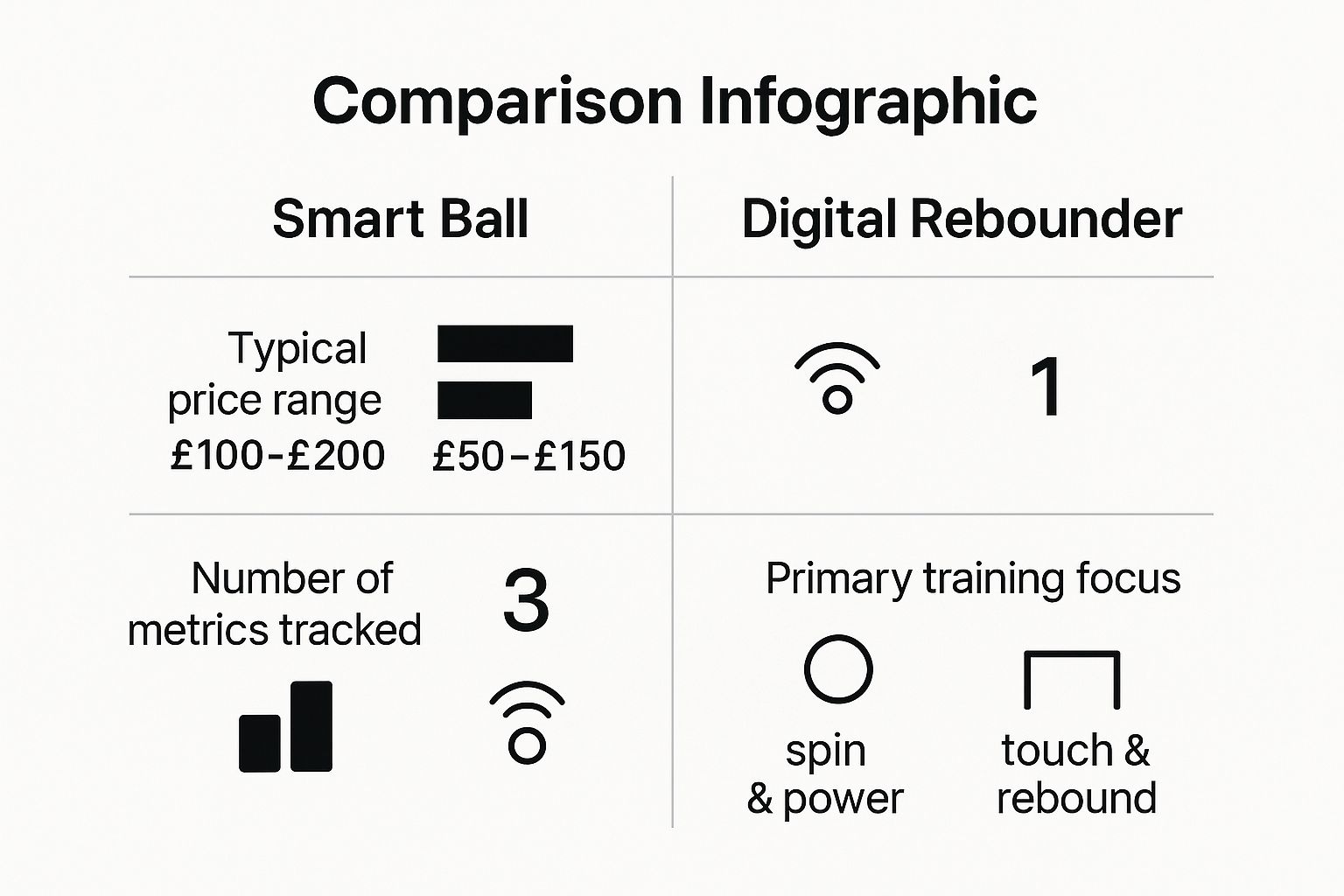
As you can see, while a smart ball might be a bigger initial investment, it tracks a wider range of kicking metrics. This makes it perfect for players who are really focused on improving their shooting and passing technique.
Choosing the Right Tool for Development
So, is a smart ball a better buy than a digital rebounder? Honestly, it completely depends on your child’s development goals. A smart ball offers incredibly detailed analysis for perfecting striking technique, making it a brilliant tool for aspiring midfielders and forwards. A digital rebounder, on the other hand, is purpose-built to improve a player’s first touch and reaction time—skills that are essential for any position on the pitch.
To get a better sense of which might be right for your young player, here’s a quick comparison of what each tool brings to the training ground.
Comparing Smart Balls vs Smart Rebounders
| Feature | Smart Football | Smart Rebounder |
|---|---|---|
| Primary Focus | Shooting & passing technique | First touch, reaction & control |
| Key Metrics | Spin, power, strike point | Pass accuracy, return speed |
| Typical Cost | £100 - £200 | £50 - £150 |
| Best For | Perfecting set-pieces & long balls | Improving close control & reactions |
| Practice Type | Solo or with a partner | Solo practice & repetitive drills |
Ultimately, a smart ball is your go-to for analysing the quality of a strike, while a rebounder sharpens the speed and precision of a player's control.
The best investment is the tool that directly addresses a player's specific area for improvement. A smart ball won't fix a poor first touch, and a rebounder can't analyse the spin on a free kick. Choose the tech that aligns with your child's needs.
At the end of the day, these aids are all about making practice more purposeful. For a deeper dive into how these devices work and which models are leading the market, check out our comprehensive smart football balls review.
Why Do Football Tech Prices Vary So Much?
Ever found yourself browsing online and wondering why one GPS tracker is £90 while another that looks almost identical costs £400? It’s a common question, and figuring out what’s behind the price tag is the key to not overspending. The differences usually boil down to a handful of core factors that separate budget-friendly gadgets from premium, pro-level gear.
Think of it like buying new football boots. A basic pair will get the job done for a kickabout in the park. But a top-of-the-line model is built with lighter materials, offers better traction, and is engineered for a perfect first touch. It’s the same principle with football tech for kids—you’re often paying for better accuracy, more detailed data, and the reliability that comes with a trusted brand.
Key Factors Driving the Cost
So, what actually makes up that price difference? Understanding these elements will help you spot whether you’re paying for genuinely useful features or just a fancy logo.
- Brand Reputation and Reliability: Big names like STATSports haven't just appeared overnight. They’ve invested years and significant funds into research, development, and ensuring their customer support is top-notch. When you buy from them, you're not just getting a device; you're buying into an ecosystem that’s been tried and tested at the highest levels.
- Data Accuracy and Precision: Cheaper tech might give you the basics, but premium devices use more advanced sensors and smarter algorithms. This means you get much more accurate numbers for crucial stats like top speed, distance covered, and player load. It’s the difference between a rough guess and a reliable picture of your child’s performance.
- Number of Metrics Tracked: An entry-level GPS tracker might show you five or six key stats. A professional system used by academies, on the other hand, could track over 20 different metrics—we’re talking acceleration, deceleration, and even detailed heat maps showing exactly where a player has been on the pitch.
This gap in what’s available and what people invest in is clear across the youth football scene.
According to data from Sport England’s Active Lives survey, parents can expect to spend anywhere from £300 to £600 per child each year on football training gear and tech. This figure changes a lot, with children at urban academies often using far more advanced kit than those at smaller community clubs. You can read more about how tech is changing UK football on maxi-jump.com.
Purchase Model: Subscription vs One-Off
Another massive factor in the total cost is how you pay for it. Some products are a simple one-off purchase—you buy the gadget, and it’s yours forever with full access to all its features. Simple.
However, many of the more advanced systems now run on a subscription model. This means you might pay less for the device itself, but you’ll need to keep paying a monthly or annual fee to use the app and see all the data. This can make the initial hit to your wallet a bit softer, but it's really important to factor those long-term subscription costs into your budget.
Budgeting Smartly for Your Child’s Football Tech
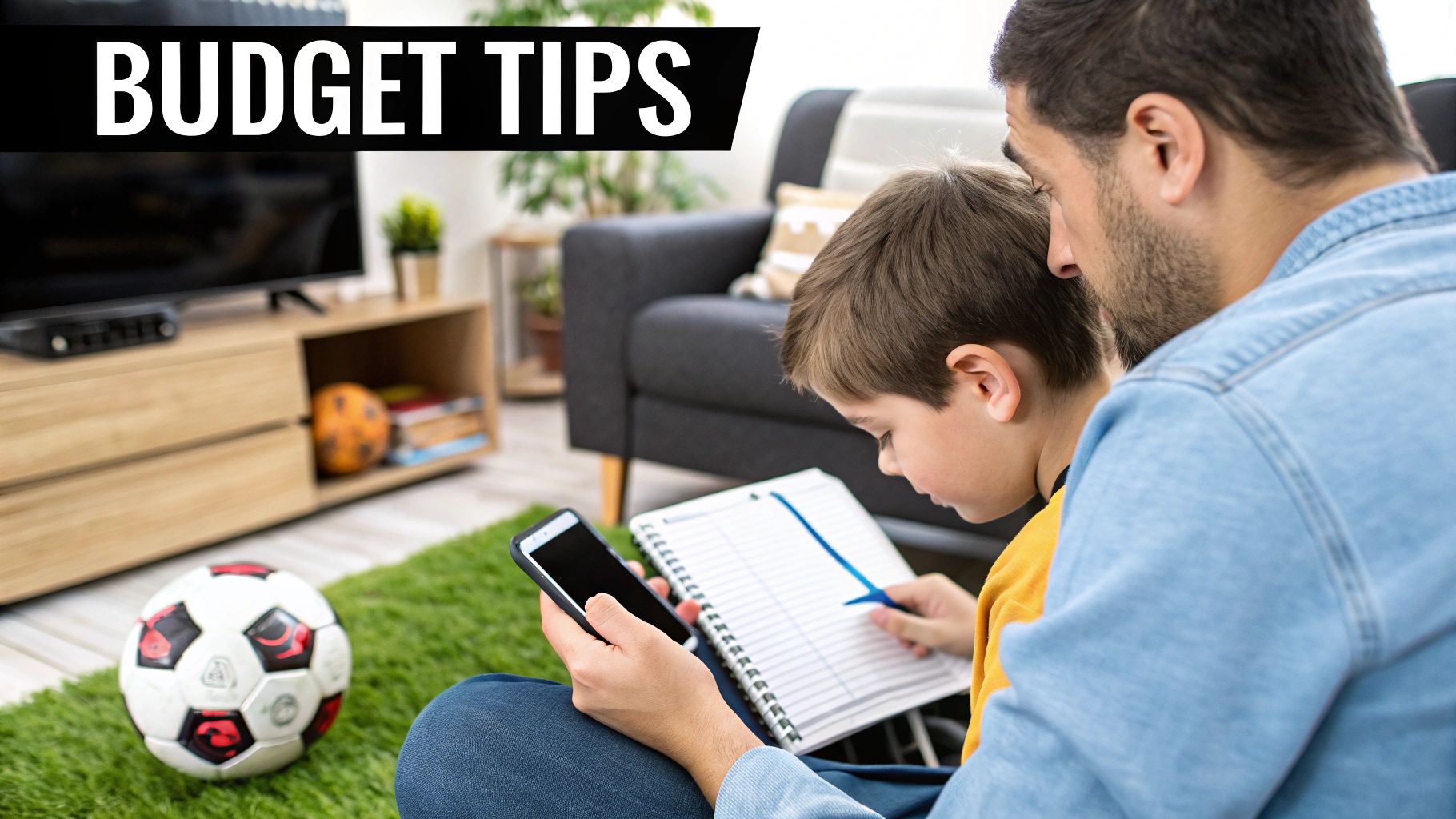
Let's be honest, investing in football tech for your child can feel daunting. But it doesn't have to empty your bank account. With smart thinking, you can give your young player the tools they need without stretching the budget too far. It’s all about being strategic and focusing on what delivers real value, not just the flashiest features.
A great first step? Test the waters with free or low-cost training apps. Before you splash out on any expensive hardware, see if your child actually sticks with a digital training routine on a phone or tablet. It’s a simple way to gauge their genuine, long-term interest.
If they’re still buzzing about it a few weeks later, then you can start looking at the gear itself. And remember, that doesn't mean you have to buy brand new. Online marketplaces and local community groups can be goldmines for second-hand equipment in fantastic condition.
Smart Shopping and Prioritising Needs
Timing is everything. Keep your eyes peeled for seasonal sales like Black Friday or end-of-season clearances. That's often when you'll see prices on football tech take a serious dip, and planning your purchases around these times can make a huge difference.
It's also crucial to match the tech to a specific need. For example, if your child is struggling with their first touch, a smart rebounder is a much smarter buy than a GPS tracker. Focus on tools that solve a real problem in their game right now. You can check out a great range of affordable football tech for kids to get a feel for what’s out there.
For many families, the annual cost of football tech can really add up. It’s not uncommon for parents to spend anywhere from £200 to over £1,000 a year on training platforms and smart gear. While clubs sometimes help out, the financial responsibility often lands squarely on the parents.
It’s also worth thinking about long-term value. Some gadgets might seem expensive upfront, but when you compare the cost to hours of one-on-one coaching, they can actually be a savvy investment, offering round-the-clock practice and feedback whenever it's needed.
Your Top Questions About Kids' Football Tech
Dipping your toes into the world of football tech can feel a bit overwhelming, especially when it comes to costs. It’s completely normal to have a bunch of questions. So, let's clear up some of the most common ones to help you figure out what’s right for your young player.
Does My Child Really Need Expensive Tech to Improve?
Honestly? Absolutely not. All the fancy gadgets in the world are no replacement for solid coaching, mastering the basics, and a real love for the game.
Think of tech as a bonus—a great training partner, but not the star player. It’s there to support and enhance development, not define it. Always prioritise the fundamentals first.
What’s the Right Age to Start Buying This Stuff?
There’s no magic number, but I’ve found that serious performance gear, like GPS trackers, really starts to pay off for players around 12 and up. At that age, they're usually in a more competitive, structured environment where data is genuinely useful.
For younger children (say, 6-11), it’s all about making practice fun.
Go for things like smart balls or interactive training apps. They’re a brilliant way to get children excited about training and build good habits without burying them in complex performance stats.
Are There Any Decent Free or Cheap Options Out There?
Yes, loads of them! You don’t have to spend a fortune to get started. There are plenty of fantastic football training apps on smartphones that are either completely free or cost just a few pounds for a one-time download.
They’re the perfect way to test the waters. Most offer guided drills, simple progress trackers, and video tutorials that are more than enough to get a young player engaged and improving.
How Can I Tell if a Product Is Actually Good Value?
Good value isn't just about the price tag; it’s about the impact it has on your child's game. The best value comes from tech that solves a specific problem. For instance, if your child struggles with their first touch, a smart rebounder could be a brilliant investment.
Always do your homework. Read reviews from other parents, watch out for sneaky subscription fees, and check how durable the product is. At the end of the day, the most valuable piece of tech is the one your child genuinely enjoys and uses week in, week out.
Ready to find the right tech to support your young player's development? Explore the curated collection of training aids and performance gear at SoccerWares. Visit https://soccerwares.com to browse our selection.

